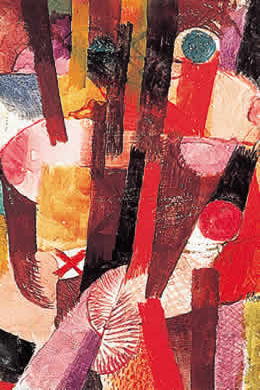Main content starts here.
Paul KLEE "Anatomy of Aphrodite"
"Anatomy of Aphrodite"
 Paul KLEE (1879-1940)
Paul KLEE (1879-1940)
1915, 20 x 13.6cm (cardboard 30.3 x 22.3)
Watercolor, chalk ground, on paper mounted on cardboard
Between the years 1913 and '15 Klee concentrated on abstract themes. In World War I, Klee wrote in his diary, "The more this world is consumed in fear the more abstract painting becomes, while, the happier the world becomes the more secular art flourishes." For himself, Klee sought to create a romantic type of abstraction with an element of pathos. This work falls into this category. While showing figurative images in the two green eyes and the genitals, there is also abundant use of red, suggesting blood.
The word anatomy perhaps comes from the way irregular shapes are scattered across the picture plane. We can see this as a dissection of the classical secular or "worldly art" which Aphrodite is so representative of. We also find that Klee took a pair of scissors to this painting. The work we see here is the center of a painting from which the right and left sides have been cut off. The two side pieces were mounted upside down on a piece of backing paper to create another work. There is a subtle irony in the fact that, in doing a painting of the goddess of love and beauty, he not only dissect her thematically but also dissected the painting as well.
- Representative Works
- About the Museum | Outline
- Collection Characteristics
- AI-MITSU "A Bird"
- KISHIDA Ryusei "Portrait of Sanada Hisakichi"
- KOYAMA Shotaro "Landscape"
- SHIMIZU Toshi "A Subway Station"
- TAKAHASHI Yuichi "Miyagi Prefectural Office"
- MATSUMOTO Shunsuke "A Painter"
- MIGISHI Kotaro "Orchestra"
- YOROZU Tetsugoro "Self-portrait"
- WATANABE Ryosuke "A Woman in the Shade of a Tree"
- ODAKE Chikuha "The Moisture of the Moon - the Heat of the Sun - the Chill of the Stars"
- TAKEHISA Yumeji "At a Glass Wholesaler in Summer"
- HAYAMI Gyoshu "Pigeon and Sparrows"
- HIRAFUKU Hyakusui "Hunting"
- SATO Churyo "Man of Gunma"
- SATO Churyo "Hat, Summer"
- Wassily KANDINSKY "Study for Panel for Edwin R. Campbell No.4 (Carnival, Winter)"
- Wassily KANDINSKY "Arrival of the Merchants"
- Paul KLEE "Palésio Nua"
- Paul KLEE "Anatomy of Aphrodite"
- Henri de TOULOUSE-LAUTREC "Le Divan Japonais"